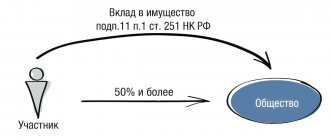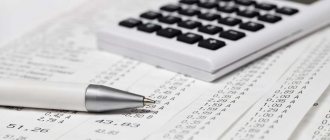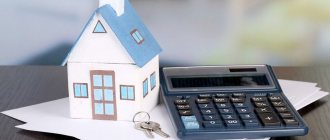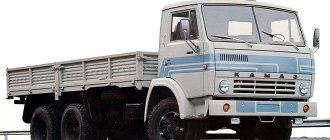1. For the purposes of this chapter, depreciable property is recognized as property, results of intellectual activity and other objects of intellectual property that are owned by the taxpayer (unless otherwise provided for by this chapter) and are used by him to generate income. Depreciable property is property, results of intellectual activity and other objects of intellectual property with a useful life of more than 12 months and an initial cost of more than 100,000 rubles.
(as amended by the Federal Law
dated September 29, 2019 N 325-FZ)
Depreciable property received by a unitary enterprise from the owner of the property of the unitary enterprise for operational management or economic management is subject to depreciation from this unitary enterprise in the manner established by this chapter.
(as amended by the Federal Law
dated May 29, 2002 N 57-FZ)
Depreciable property received by an investor organization from the owner of the property in accordance with the legislation of the Russian Federation on investment agreements in the field of providing public services is subject to depreciation from this organization during the validity period of the investment agreement in the manner established by this chapter.
(paragraph introduced by Federal Law
dated August 20, 2004 N 110-FZ)
Property related to mobilization capacities is subject to depreciation in the manner established by this chapter.
(paragraph introduced by Federal Law
dated November 29, 2012 N 206-FZ)
Depreciable property is recognized as capital investments in leased fixed assets in the form of inseparable improvements made by the lessee with the consent of the lessor, as well as capital investments in fixed assets provided under a free use agreement in the form of inseparable improvements made by the borrower organization with the consent of the lending organization .
(as amended by the Federal Law
dated July 22, 2008 N 158-FZ)
Depreciable property received by an organization from the owner of the property or created in accordance with the legislation of the Russian Federation on investment agreements in the field of activities for the provision of public utilities or legislation
of the Russian Federation on concession agreements, is subject to depreciation from this organization during the period of validity of the investment agreement or concession agreement in the manner established by this chapter.
(paragraph introduced by Federal Law
dated 06.06.2005 N 58-FZ, as amended.
Federal Law
of June 30, 2008 N 108-FZ)
2. Land and other natural resources (water, subsoil and other natural resources), as well as inventories, goods, capital construction projects in progress, securities, derivative financial instruments (including forward, futures, option contracts) are not subject to depreciation contracts).
(as amended by Federal Laws dated May 29, 2002 N 57-FZ
, dated 07/03/2016
N 242-FZ
)
The following types of depreciable property are not subject to depreciation:
(as amended by the Federal Law
dated May 29, 2002 N 57-FZ)
1) property of budgetary organizations, with the exception of property acquired in connection with the implementation of entrepreneurial activities and used to carry out such activities;
(as amended by the Federal Law
dated July 24, 2002 N 110-FZ)
2) property of non-profit organizations received as earmarked proceeds or acquired at the expense of earmarked proceeds and used to carry out non-commercial activities;
(Clause 2 as amended by the Federal Law
dated May 29, 2002 N 57-FZ)
3) property acquired (created) using budget funds for targeted financing. This norm does not apply to property received by the taxpayer during privatization;
(as amended by Federal Laws dated May 29, 2002 N 57-FZ
, dated July 23, 2013
N 215-FZ
)
4) external improvement facilities (forestry facilities, road facilities, the construction of which was carried out with the involvement of sources of budgetary or other similar targeted funding, specialized navigation facilities) and other similar facilities;
(as amended by the Federal Law
dated May 29, 2002 N 57-FZ)
5) has become invalid. - The federal law
dated July 22, 2008 N 135-FZ;
6) purchased publications (books, brochures and other similar objects), works of art. At the same time, the cost of purchased publications and the cost of cultural property acquired by museums that are budgetary institutions to the Museum Fund of the Russian Federation are included in other expenses associated with production and sales in full at the time of acquisition of these objects;
(as amended by Federal Laws dated May 29, 2002 N 57-FZ
, dated July 23, 2013
N 215-FZ
)
7) excluded. - The federal law
dated May 29, 2002 N 57-FZ;
) property acquired (created) at the expense of funds received in accordance with
subparagraphs 14
,
19
,
22
,
23
and
30 of paragraph 1 of Article 251
of this Code, as well as property specified in
subparagraphs 6
and
7 of paragraph 1 of Article 251
of this Code;
(as amended by Federal Laws dated May 29, 2002 N 57-FZ
, dated December 31, 2002
N 191-FZ
, dated December 29, 2004
N 204-FZ
)
 acquired rights to the results of intellectual activity and other objects of intellectual property, if, under an agreement for the acquisition of these rights, payment must be made in periodic payments during the term of the said agreement;
acquired rights to the results of intellectual activity and other objects of intellectual property, if, under an agreement for the acquisition of these rights, payment must be made in periodic payments during the term of the said agreement;
(Clause 8 introduced by Federal Law
dated May 29, 2002 N 57-FZ)
ConsultantPlus: note.
From January 1, 2028 by Federal Law
dated November 27, 2017 N 335-FZ, subparagraph 9 of paragraph 2 of Article 256 is declared invalid.
9) objects of fixed assets in respect of which the taxpayer used the right to apply an investment tax deduction, taking into account the specifics established by paragraph 7 of Article 286.1
this Code;
(Clause 9 introduced by Federal Law
dated November 27, 2017 N 335-FZ)
10) property created as a result of the work specified in subclause 11.2 of clause 1 of Article 251
this Code;
(Clause 10 introduced by Federal Law
dated November 27, 2018 N 424-FZ)
ConsultantPlus: note.
pp. 11 clause 2 art. 256 (as amended by Federal Law No. 121-FZ dated April 22, 2020) applies
for legal relations arising from 01/01/2020.
11) medical products, the purchase costs of which are taken into account by the taxpayer in accordance with subclause 48.12 of clause 1 of Article 264
this Code;
(Clause 11 introduced by Federal Law
dated April 22, 2020 N 121-FZ)
12) objects of fixed assets in respect of which the taxpayer used the right to apply a tax deduction in accordance with Article 343.6
this Code;
(Clause 12 introduced by Federal Law
dated July 13, 2020 N 195-FZ)
13) intangible assets created as a result of expenses incurred on scientific research and (or) development, in respect of which the taxpayer exercised the right to apply an investment tax deduction, taking into account the specifics established by paragraph 7 of Article 286.1
of this Code.
(Clause 13 introduced by Federal Law
dated November 23, 2020 N 374-FZ)
3. For the purposes of this chapter, fixed assets are excluded from depreciable property:
paragraph no longer in force on January 1, 2021. - The federal law
dated September 29, 2019 N 325-FZ;
transferred by decision of the organization’s management to conservation for a period of more than three months;
those that, by decision of the management of the organization, are undergoing reconstruction and modernization for a period of more than 12 months, with the exception of cases where fixed assets in the process of reconstruction or modernization continue to be used by the taxpayer in activities aimed at generating income;
(as amended by the Federal Law
dated November 29, 2014 N 382-FZ)
the paragraph is no longer valid. - The federal law
dated June 4, 2018 N 137-FZ.
When an object of fixed assets is re-mothballed, depreciation on it is accrued in the order that was in effect before the moment of its mothballing.
(as amended by the Federal Law
dated September 29, 2019 N 325-FZ)
(Clause 3 as amended by the Federal Law
dated 07.11.2011 N 305-FZ)
4. Depreciation accrued on fixed assets transferred for free use to state authorities and local governments, state and municipal institutions, state and municipal unitary enterprises in cases where this obligation of the taxpayer is established by the legislation of the Russian Federation, is taken into account when determining the tax base in accordance with Article 274
of this Code.
(Clause 4 introduced by Federal Law
dated November 29, 2014 N 382-FZ)
Depreciable property not subject to depreciation
This group includes:
- Material assets of budgetary organizations. The exception here is property acquired in the course of business activities and used for its implementation.
- The assets of non-profit organizations that are received in the form of targeted proceeds or purchased with targeted funds and are used to conduct the main non-profit activities.
- Valuables purchased with budget funds. An exception is property received by the subject during privatization.
- Objects of improvement, forestry, road management, the creation of which was carried out with the involvement of budgetary or other similar targeted funding, specialized structures for shipping purposes and other similar objects.
- Purchased publications (brochures, books, etc.), works of art. The cost of such objects (except for works of art) is included in other expenses associated with the production and sale of products at the time of purchase in full.
- Buffaloes, productive livestock, deer, oxen, yaks and other domesticated animals, except draft animals.
- Acquired rights to products of intellectual work or other intellectual property, if, according to the purchase and sale agreement, payments must be made periodically during its validity period.
What are intangible assets?
These are the products of intellectual activity acquired or created by taxpayers, as well as other objects of mental values that give the owner exclusive rights and are used in the creation of products, for example, works and services, or for the needs of managing an organization for a sufficiently long period of time, amounting to more than twelve months.
It is important to remember which fixed assets are not subject to depreciation.
An intangible asset is recognized in a number of the following cases:
- the ability to bring economic benefits in the form of profit;
- correctly executed documents that confirm the existence of an intangible asset and a unique right to it.
Intangible assets mainly include:
- the right of the patent holder to a utility model, in addition to an invention, or a design of an industrial nature, which belongs exclusively to him;
- the unique right of the author-developer or other owner to use certain programs for electronic computers, and, accordingly, databases of all kinds of data;
- copyright or the use of integrated circuit topologies, which is also exclusive to him;
- awarding any trademark or service mark, as well as assigning a unique name to the place of origin of goods and developing a company name for them;
- the exclusive right of the patent holder to achievements in the field of the breeding sector;
Are land plots subject to depreciation? The answer to this question is negative, although land is considered a fixed asset.
The initial value of depreciable and intangible assets is calculated based on the amount of expenses for their creation or receipt and bringing them to the state where they become suitable for use, with the exception of value added tax and excise taxes. The price of intangible assets that are created by the institution itself is calculated as the amount of actual expenses for their production and creation.
Additionally
The following assets are also excluded from depreciable items:
- Transferred to conservation for more than three months.
- Received/transferred under a free use agreement.
- Those undergoing modernization/reconstruction, lasting more than 12 months.
When depreciating property is re-mothballed, depreciation amounts are accrued in accounting in the manner that existed before mothballing, and the useful life period is increased by its duration.
The initial price of an asset is determined as the sum of the costs of acquiring it and bringing it into a state of readiness for operation.
Groups of depreciable property
They are formed depending on the period of useful use of the objects.
An economic entity may, at its discretion, increase the period after the date of commissioning if modernization, reconstruction, technical re-equipment (re-equipment) led to an increase in the service life of the asset.
For convenience, groups of objects are shown in the table.
| Group | Duration of use (in years, inclusive) |
| 1 | 1-2 |
| 2 | 2-3 |
| 3 | 3-5 |
| 4 | 5-7 |
| 5 | 7-10 |
| 6 | 10-15 |
| 7 | 15-20 |
| 8 | 20-25 |
| 9 | 25-30 |
| 9 | More than 30 years |
The classification of OS included in groups is approved by the Government.
Where is the linear method applicable?
The straight-line method is applicable to structures, buildings and transfer inventions that are included in depreciation groups in the range from eight to ten. For other fixed assets, taxpayers can use any of the methods. The selected method cannot be changed during the entire period of depreciation calculations. It is important to first understand whether this type of property is subject to depreciation.
It should be noted that in cases where the fixed asset in relation to which the specified rights were used no earlier than after five years from the date of its operation, as well as a person dependent on the taxpayer and his amount of expenses previously included in the composition of expenses of the next tax period must certainly be included in the number of unrealized incomes in the reporting period in which such sales were carried out. This rule has been applied within the framework of the use of fixed assets since the beginning of January 2013 in accordance with Federal Law 206.
General information about the calculation of depreciation amounts
Calculation of depreciation of depreciable property, in accordance with Art. 25 NK, produced in a linear or non-linear way.
A business entity determines the amount of depreciation for tax purposes separately for each asset on a monthly basis. Accrual begins on the 1st day of the month following the month the facility was put into operation. The calculation also stops on the 1st day of the month following the month of write-off of fixed assets or disposal of depreciated property for any reason.
Clause 4 of Article 256 of the Tax Code of the Russian Federation
Depreciation accrued on fixed assets transferred for free use to government and local government bodies, state and municipal institutions, state and municipal unitary enterprises in cases where this taxpayer obligation is established by the legislation of the Russian Federation, is taken into account when determining the tax base in accordance with with Article 274 of this Code. (Clause introduced - Federal Law dated November 29, 2014 No. 382-FZ)
(This article was introduced by Federal Law No. 110-FZ of August 6, 2001)
←Article 255 of the Tax Code of the Russian Federation, Article 257 of the Tax Code of the Russian Federation→
Features of accrual
When using the linear method, the amount of depreciation is determined as the product of the original cost of fixed assets and the depreciation rate. The latter is calculated as follows:
K = [1/n] x 100%.
In this formula:
- depreciation rate as a percentage of the original cost – K;
- the period of useful operation of the object, expressed in months, - n.
If a non-linear method is used, then the required value is determined by multiplying the residual value of the depreciable property by the rate:
K = [2/n] x 100%.
Odds
They are used when calculating the amount of depreciation of depreciated property operated in aggressive conditions or with increased shifts. The coefficients can also be used by agricultural enterprises: greenhouse plants, poultry farms, livestock farms, etc. However, some restrictions are established.
In particular, the specified entities can use a coefficient no higher than 2. For fixed assets that are the subject of a leasing agreement, it is allowed to use a coefficient no higher than three in the calculation.
These provisions do not apply to objects included in groups 1-3 if a non-linear method is used.
Aggressive are artificial or natural factors, the influence of which causes increased wear of the OS. Operating in such conditions also equates to the presence of property in contact with a fire, explosive, toxic or other aggressive environment, which is the source (cause) of an emergency.
When calculating depreciation amounts for passenger minibuses and cars, the original cost of which is more than 400 thousand rubles. and 300 thousand rubles. Accordingly, a coefficient of 0.5 is applied to the basic norm.
By decision of the head of the enterprise, depreciation can be calculated at reduced rates, but only from the beginning of the tax period and throughout it.
Concept
All material resources wear out over time. In practice, there are two types of wear:
- Physical. The product failed and began to work intermittently and with other breakdowns.
- Moral. The product, method, process, algorithm are outdated and do not meet modern requirements.
Therefore, it is fair that in accounting the initial cost of fixed assets, as well as any intangible assets as they wear out, is transferred in parts to the cost of products that are produced or provided by a company or enterprise.
It is this transfer process that is called depreciation. Moreover, in an accounting context, depreciation is the amount of amortized funds that have been accrued from the moment they were used.
What objects are not subject to depreciation? We will definitely look into this further.
Taxation
For OS put into operation before the entry into force of Ch. 25 of the Tax Code, the useful life is determined by the business entity itself as of 01/01/2002, taking into account the classification approved by the Government and the periods of operation by group, enshrined in Art. 258 of the Code.
Regardless of the accrual method chosen by the taxpayer in relation to depreciated property put into operation before the entry into force of Ch. 25, the calculation is carried out based on the residual value.
Analytical accounting
It should reflect information about:
- The initial cost of an object disposed of in the tax (reporting) period, as well as its changes during additional equipment, completion, partial liquidation, reconstruction.
- Periods of useful operation accepted by the enterprise.
- Accrual methods and depreciation amounts from the beginning of calculation to the end of the month in which the sale (disposal) of the object took place.
- The cost of selling the property in accordance with the contract.
- The date of acquisition and sale (disposal) of fixed assets, its transfer into operation, exclusion from the composition of depreciable objects on the grounds set out in clause 3 of Art. 256 of the Tax Code, reactivation of the asset, expiration of the agreement on free use, completion of modernization and reconstruction work.
- Expenses incurred by the entity upon disposal of property. We are talking, in particular, about the costs provided for in subsection. 8 clause 1 art. 265 Tax Code, as well as the costs of storage, transportation and maintenance of the sold asset.
The profit received by a business entity is included in the tax base in the reporting period in which the sale was made. Losses incurred by the taxpayer are reflected in accounting as other expenses, in accordance with the rules established by Art. 268 NK.
Analytical accounting must contain information about the name of the assets in respect of which the amounts of the corresponding costs are recorded, the number of months during which they will be included in other expenses, as well as the amount of monthly costs.
Nonlinear method
This method takes into account the amount of depreciation for thirty days, which is calculated based on the balance sheet, which is of a summary nature, in relation to the corresponding depreciation subgroup at the beginning of the month and the norms required in this case. The total amount of depreciation accrued for thirty days is calculated using the formula: A = (K /100) x B. In this example, A refers to the amount that was calculated for one month of depreciation for any suitable group. B acts as the total balance. K is the depreciation rate itself, calculated for the corresponding classification group.
From the month that follows when the residual value reaches twenty percent of the replacement and original cost of the object, the amount of depreciation is calculated in the following order:
- the residual price of the object is entered as the base cost for subsequent calculations;
- the amount of accrued depreciation for thirty days is calculated by dividing the original cost by the sum of the months that remain until the end of the current period of active use.








